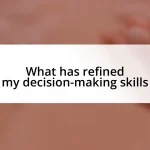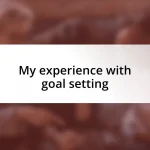Key takeaways:
- Reflection on career gaps and mentor influence propelled the decision to pursue certification.
- Defining clear learning objectives and building a flexible study schedule enhanced focus and engagement.
- Engaging with the certification community provided motivation, support, and insights from mentors.
- Applying theoretical knowledge in real-life situations solidified learning and showcased its practical impact.

What inspired my certification choice
When I first considered pursuing a certification, I found myself reflecting on my career ambitions and the gaps I wanted to fill. I remember a moment during a project at work where I felt overwhelmed; it made me question my preparedness and skills. That experience sparked a desire to gain more knowledge and credibility in my field, and I began to wonder: what if I could turn those feelings of inadequacy into a powerful, motivating force?
Another pivotal moment came from witnessing a mentor’s success after earning their certification. Their confidence and expertise were undeniable, and I couldn’t help but think, “If they can elevate their career so significantly, what’s stopping me?” This realization lit a fire in me; I wanted that level of respect and assurance in my own work. It felt like a clear path was forming before me, one I was eager to travel.
As I explored various options, I was drawn to a certification that resonated deeply with my passions. I vividly recall sitting at my desk, reading about the curriculum, and feeling a surge of excitement wash over me. Would this be the key to unlocking new opportunities? The thought filled me with hope and purpose, pushing me to commit fully to this journey of growth.

Defining clear learning objectives
Defining clear learning objectives was a game-changer for me during my certification journey. I vividly recall sitting down with a notebook, pen in hand, and really thinking about what I wanted to accomplish. It felt empowering to break down my goals into specific, measurable skills. When I pinpointed these objectives, everything else fell into place, guiding my study sessions and keeping me focused.
- Identify the core competencies needed for success in your field.
- Determine realistic milestones to track your progress.
- Prioritize which skills to master first based on your current knowledge and experience.
- Revisit and adjust your objectives as you grow; flexibility is key.
- Celebrate small wins along the way to stay motivated.
Each learning objective felt like a little victory. I remember reaching one, one of my targets, and it was exhilarating to see how it translated into real-world application. By defining these goals clearly, I found myself not just learning but transforming my approach to challenges. It turned a daunting process into a series of meaningful achievements, all building my confidence as I moved forward.

Building a study schedule
Building a study schedule was crucial for me as it provided a structured approach to tackle the vast content. I remember the overwhelming feeling when I first looked at the syllabus; it felt like climbing a mountain. To ease that anxiety, I dedicated time to mapping out a study calendar that reflected my personal rhythms and energy peaks, ensuring efficient and productive study sessions. I can’t emphasize enough how satisfying it was to physically check off tasks as I progressed through my plan.
I soon realized that flexibility within this schedule was key. Some days, I found my enthusiasm waning, while on others, I was ready to dive deeper into complex topics. By allowing myself the grace to adjust my study blocks, I maintained motivation. On afternoons when I was particularly energized, I would tackle challenging chapters, and on more sluggish days, I’d review easier content. This adaptive approach not only kept the journey enjoyable but also kept me engaged with the material consistently.
Reflecting on my experience, I believe that incorporating buffer days into my study schedule truly saved me from burnout. I didn’t just plan for study sessions; I also reserved time for breaks, which proved vital. There was this one Saturday when I chose to step away from my books in favor of exploring a local park. That break allowed me to return recharged, brimming with fresh perspectives that vastly improved my productivity in subsequent sessions. Balancing study and self-care made all the difference!
| Pros | Cons |
|---|---|
| Structured approach to learning | Possibility of feeling restricted |
| Achievement of small goals keeps motivation high | Over-scheduling can lead to stress |
| Flexibility allows for adapting to energy levels | Need for self-discipline to stick to the schedule |

Engaging with the certification community
Engaging with the certification community was one of the highlights of my journey. I remember joining online forums and local study groups, where I connected with fellow learners who shared similar aspirations. There’s something incredibly motivating about exchanging ideas and experiences—it’s like being part of a tribe where everyone is cheering for your success. Do you know that feeling when someone just gets you? That’s how it felt to discuss challenges and triumphs with others on the same path.
One particularly memorable moment occurred during a virtual study session, where we tackled challenging practice questions together. I can still recall the electric atmosphere filled with anticipation and camaraderie. When someone would solve a problem I had been struggling with, I felt a surge of encouragement. What was even more enriching was when we took turns explaining our thought processes; it helped me understand the material on a deeper level and fostered a sense of belonging. I often wonder how many breakthroughs in understanding are sparked by collaboration—it truly feels invaluable.
I also sought out mentorship within this community, reaching out to seasoned professionals who had already traversed the certification landscape. Their insights felt like golden nuggets of advice that guided my strategy and approach. I vividly remember one mentor prescribing a unique resource that made a complex topic click for me. It was as if a light bulb had gone on, and I think this exemplifies how engaging with the community can amplify knowledge and inspire growth. How often do we underestimate the power of connection? For me, it was a pivotal component of my journey, making the process not just about certification but about building a network that supports lifelong learning.

Overcoming challenges during preparation
There were definitely moments that tested my resolve during my preparation. I distinctly remember facing a particularly dense chapter that left me feeling overwhelmed and anxious. It felt like staring at a puzzle with too many pieces, unsure of where to start. Instead of surrendering to frustration, I decided to break it down into smaller sections. This approach turned a daunting task into manageable bites. How often have we felt intimidated by a huge undertaking? Taking it step-by-step taught me the importance of perseverance and patience in the learning process.
Time management was another significant hurdle. Balancing work, study, and personal commitments often felt like juggling flaming torches, and there were days when I felt I was about to drop one. I vividly recall a week where a sudden work project demanded my full attention just as an important exam approached. To navigate this, I learned to communicate openly with my colleagues about my constraints, allowing me to carve out focused study periods. Have you ever had to navigate competing priorities? For me, embracing open dialogue and setting clear boundaries became essential strategies that transformed challenges into opportunities for growth.
One of the most enlightening lessons was realizing that setbacks were part of the journey. After receiving feedback on a practice exam where I didn’t perform as well as expected, a wave of disappointment washed over me. It felt like a step backward, and I was tempted to spiral into self-doubt. Instead, I took a moment to reflect and identified specific areas for improvement. This reflection not only clarified my study path but also reinforced my resilience. I often ask myself, how can we truly grow without facing challenges head-on? In embracing these lessons, I discovered that every obstacle was an opportunity to learn and adapt, ultimately enriching my certification journey.

Applying knowledge in real-life situations
Applying the theoretical knowledge from my certification study into real-life situations was an eye-opening experience. I distinctly remember the first time I applied what I had learned during a project at work. As I implemented the new strategies, I felt a rush of confidence—something clicked. Have you ever had that moment when theory meets practice? It’s not just about recalling facts; it’s about seeing the tangible impact of your learning in action.
One particular challenge arose when I was tasked with resolving a complex issue that seemed to defy all my previous attempts. Instead of relying solely on instinct, I dug into my certification material for guidance. As I sifted through my notes, I realized I had a clear framework to tackle the problem. Suddenly, those late-night study sessions felt worthwhile, as I successfully navigated the situation using the principles I’d learned. This moment truly showcased how education moves beyond textbooks and into the daily decisions we make.
Moreover, I think it’s fascinating how this journey taught me to view challenges through a different lens. There was a time when I faced pushback from team members about implementing a new approach I had championed. In that moment, I felt a mix of anxiety and determination. Instead of retreating, I started sharing the insights from my certification training, including data-driven evidence to back my proposals. Did you ever find yourself advocating for an idea in a room full of skeptics? It can be intimidating, but it solidified my belief in the applications of what I had learned, transforming theoretical knowledge into actionable plans in the workplace.

Celebrating milestones and achievements
Celebrating milestones during my certification journey was like collecting beautiful stones along a path; each one represented progress and hard work. I still remember the rush of joy when I completed my first module. It felt like I was gathering momentum, and I couldn’t help but share the news with friends and family. The encouraging responses fueled my determination. Has there ever been a moment in your life that made you pause and reflect on how far you’ve come?
Then came the day I tackled my first full practice exam. As I clicked the “submit” button, my heart raced with anticipation. When those results popped up on the screen, it felt like I’d conquered a mountain. I wasn’t perfect, but seeing my efforts translate into tangible scores was monumental. It motivated me to strategize and study harder for areas of improvement. Can you recall a time when hard work turned into a moment of validation for you? Those little victories added up and spurred me onward.
Every completed certification requirement was an occasion worth celebrating, no matter how small. I created a little ritual for myself; after each milestone, I would treat myself to a favorite snack or take a moment to enjoy a relaxing activity. It added a layer of joy to the process. I realized that acknowledging these achievements helped to maintain my momentum. What are some ways you reward yourself for hard-earned accomplishments? For me, this intentional recognition not only marked progress but also reinforced my commitment to the journey ahead.














